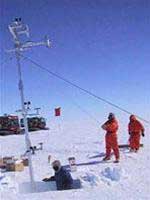The Chinese research vessel Xuelong set sail for Antarctica today with the mission to establish its third scientific research station and an automatic meteorological observation station.
 |
|
Chinese scientists during a previous Antarctic expedition. |
During this 130-day journey, China will officially name approximately 40 islands in Chinese and create a map at a scale of 1:500,000 for the region.
The ship’s route will include Grove Mountain, one of the last pristine territories in the world, which is also home to many unstudied meteorites.
One of the expedition’s goals is to collect as many meteorites as possible to elevate China to the second position globally in terms of meteorite ownership, surpassing the United States and only trailing behind Japan.
According to People’s Daily, China is the first country to conduct scientific exploration at Grove Mountain. Research on these meteorite samples will provide China with valuable data for its ambitious space exploration plans. In previous Antarctic expeditions, China has returned with 4,480 meteorite samples, including many from Mars.
To date, China has established two scientific stations in Antarctica: the Great Wall Station and Zhongshan Station. The Museum of Chinese History has commissioned the delegation to bring back rock samples, as well as various animal and plant species, and they plan to dedicate a space to showcase the expedition’s achievements in Antarctica.


















































